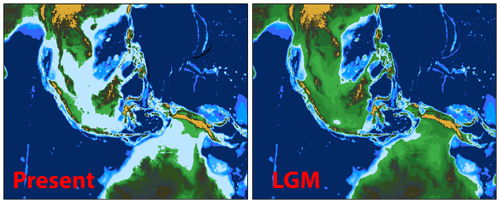The climate of the Indo-Pacific warm pool
at the Last Glacial Maximum
By:
Pedro DiNezio
University of Hawaii
Join us for coffee beginning at 10:00 a.m.
Click for a Live Broadcast.

Abstract
During the Last Glacial Maximum (LGM), temperatures within the Indo-Pacific warm pool (IPWP) were cooler than today and precipitation patterns were altered, but the mechanism responsible for these shifts remains unclear. Previous proxy and model studies have emphasized the role of the Pacific Ocean, in particular changes in the zonal sea-surface temperature gradient driven by greenhouse gas forcing.
In my talk I will present results showing the importance of the Indian Ocean, in particular changes driven by lowered glacial sea level. I will explore these ideas combining a network of 100+ proxy records with a multi-model ensemble of LGM simulations. This proxy-model synthesis suggests a key role for changes in tropical convection over the Sunda and Sahul shelves, which were subaerially exposed at the LGM due to the 120 m sea level drop.
In the second part I will test this hypothesis using new climate model simulations performed with the Community Earth System Model Version 1 (CESM1). The simulations confirm that the changes in atmospheric circulation are initiated by the exposure of the shelves, in particular the Sahul shelf. More importantly, we find that ocean dynamical processes in the Indian Ocean amplify the response resulting in a large climatic reorganization in which a cold tongue develops in the eastern part of the basin, much like in the modern day Pacific.
Last we explore the role of other LGM forcings, such as ice sheets and greenhouse gases (GHG). We find a role for northern hemisphere ice sheets, which explain the drier conditions in the northern part of the IPWP. The response to reduced GHG forcing shows wetter IPWP consistent with a stronger Walker circulation. This response is overwhelmed by the drying driven by sea level and ice sheets and therefore cannot be identified in the proxy data.
Few climate models participating in the Paleo Model Intercomparison Project (PMIP) are capable of simulating this response.




